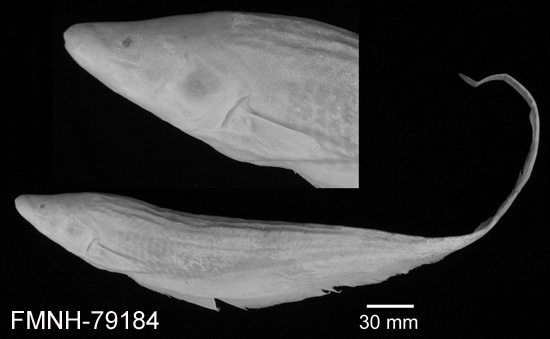Sternopygidae - Sternopygus arenatus (Eydoux & Souleyet, 1850) |
 |
| SOURCE FOR OCCURRENCE IN ECUADOR: This species is common in the Guayas basin. There are many references for its occurrence in the area (e.g., Eigenmann, 1922; Ovchynnyk, 1971; Barnhill et al., 1974; Glodek, 1978; Albert, 2001; Crampton et al., 2004; Hulen et al., 2004; Laaz et al., 2009; Laaz & Torres, 2010; Eschmeyer and Fricke, 2011). |
| ORIGINAL DESCRIPTION: Eydoux, J.F.T. and F.A. Souleyet. 1850. Poissons. Pp. 155-216. In: Voyage autour du monde execute pendant les annees 1836 et 1837 sur la corvette La Bonite, commandee par M. Vaillant. Zoologie, Vol. 1 (pt 2). Paris. Voyage autour du monde execute pendant les annees 1836 et 1837 sur la corvette La Bonite, commandee par M. Vaillant. Zoologie 1(pt 2):i-iv, i-xxxix, 1-334, Pls. 1-10. |
| TYPE SPECIMENS: |
| TAXONOMIC STATUS: Valid (Eschmeyer and Fricke, 2011). |
| RANGE ECUADOR: Guayas River basin (Laaz et al., 2009; Laaz & Torres, 2010; Eschmeyer and Fricke, 2011); Esmeraldas and Santiago River drainages (Glodek, 1978). |
| RANGE OUTSIDE OF ECUADOR: None. |
| COLLECTIONS IN ECUADOR: |
| MAXIMUM SIZE: 120 cm (Laaz et al., 2009). |
| DISTINGUISHING FEATURES: Sternopygus arenatus is an elongate gymnotiform fish. It is distinguished from other gymnotiform species in western Ecuador by the absence of a dark humeral spot; dorsal margin of snout profile straight (Hulen et al., 2004); no caudal fin or dorsal fin, free orbital present, snout short and stout, mouth terminal and jaws equal (Glodek, 1978); the anal fin is very long, the anus is close to the isthmus and eyes are covered by a protective cover (Laaz et al., 2009). |
| ECOLOGY: Sternopygus arenatus is known in Ecuador as the “bio” and is a large, ecologically important carnivorous fish. This species has nocturnal habits and uses electric organs located on the sides of its body to locate prey. Stomach contents of specimens examined included crabs, fish, and shrimp (Laaz et al., 2009). |
| ECONOMIC IMPORTANCE: This is an important food fish for people in rural parts of Guayas province (Laaz et al., 2009). |
| CONSERVATION STATUS: NA, although the species is heavily exploited as a food species. |
| LINK TO FISHBASE PAGE: Click here for link |
| SPECIES PROFILE CREATED BY: Enrique Laaz |
| SPECIES PROFILE CONTRIBUTORS: NA |
|
|
|
|
|
